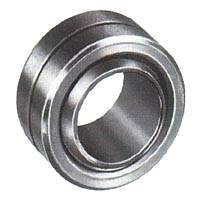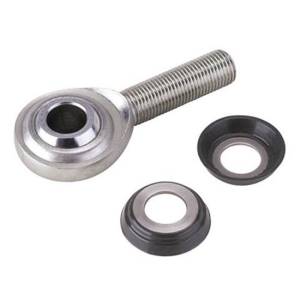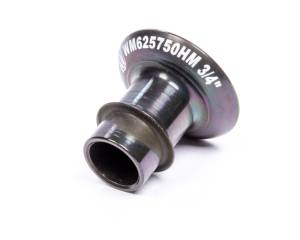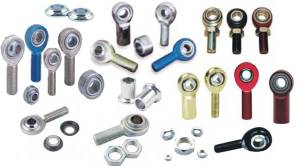- Home »
- Catalog »
- Suspension Components »
- Rod Ends & Mono Ball Bearings
PitStopUSA.com - Rod Ends & Mono Ball Bearings
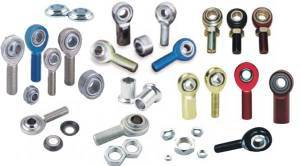
Racers and auto enthusiasts use rod ends for a variety of applications. Pit Stop USA carries a huge selection of rod ends and spherical bearings made from mild steel, chromemoly/alloy steel, aluminum, and stainless steel. Aluminum rod ends are designed specifically for performance applications where weight is a concern. With the wide variety of rod end styles available, PitStopUSA.com is sure to have exact rod ends you need for your race car.
Rod ends are used to connect the ends of control rods, steering links and other tie rods used for mechanical control. A rod end provides an effective point-to-point contact with the center of rotation lying on the axis of both attached shafts. This simplifies kinematic design and provides rigid mechanisms which do not subject control rods to bending moments. These properties make rod ends ideal for mechanisms requiring precise and predictable control. They were first developed for aircraft control systems in World War II — and have since become widely used in vehicle steering links and many other applications. For mechanisms where the axes of both rods will remain mutually perpendicular and actuation will only cause rotation one of these axes, a clevis may be used. The advantage of a rod end is in allowing three axis rotation between the components.
A ball joint with perpendicular threaded mountings may sometimes be used as a direct replacement for a rod end.
Rod ends normally have a plane hole passing through the center of the spherical joint and a protrusion from the casing surrounding the spherical joint. The protrusion may be a shaft which is typically threaded, in which case the rod end may be described as ‘male’. Alternatively, the protrusion may be a rod containing a tapped hole, this may be described as a ‘female’ rod end. It is common for the protrusion to have a hexagonal section or two parallel flats, dimensioned to fit a standard size of spanner and intended to facilitate tightening of a screw or lock nut.
A ball joint linkage, with its mounting axes nominally perpendicular to each other is very similar to a rod end. They differ in that the inner spherical surface does not have a hole through its center. Instead a ball joint has a shaft protruding from the inner ball or sphere.
Select a Sub-Category
Popular Brands:
-
A-1 Racing Products
-
AFCO Racing Products
-
Alinabal Rod Ends
-
Allstar Performance
-
Aurora Rod Ends
-
Bilstein Shocks
-
Borgeson
-
Chassis Engineering
-
Competition Engineering
-
CSR Performance Products
-
DMI
-
FK Rod Ends
-
Flaming River
-
Ford Racing
-
Howe Racing Enterprises
-
King Racing Products
-
M&W Aluminum Products
-
Meziere Enterprises
-
MPD Racing
-
Mr. Gasket
-
Out-Pace Racing Products
-
Penske Racing Shocks
-
Pro Shocks
-
QA1
-
RideTech
-
Seals-It
-
SPC Performance
-
Strange Engineering
-
Sweet Manufacturing
-
T & D Machine
-
Ti22 Performance
-
Tilton Engineering
-
Triple X Race Components
-
UB Machine
-
Wehrs Machine
-
Wilwood Engineering
-
Winters Performance Products
More About Rod Ends & Mono Ball Bearings
Racers and auto enthusiasts use rod ends for a variety of applications. Pit Stop USA carries a huge selection of rod ends and spherical bearings made from mild steel, chromemoly/alloy steel, aluminum, and stainless steel. Aluminum rod ends are designed specifically for performance applications where weight is a concern. With the wide variety of rod end styles available, PitStopUSA.com is sure to have exact rod ends you need for your race car.
Rod ends are used to connect the ends of control rods, steering links and other tie rods used for mechanical control. A rod end provides an effective point-to-point contact with the center of rotation lying on the axis of both attached shafts. This simplifies kinematic design and provides rigid mechanisms which do not subject control rods to bending moments. These properties make rod ends ideal for mechanisms requiring precise and predictable control. They were first developed for aircraft control systems in World War II — and have since become widely used in vehicle steering links and many other applications. For mechanisms where the axes of both rods will remain mutually perpendicular and actuation will only cause rotation one of these axes, a clevis may be used. The advantage of a rod end is in allowing three axis rotation between the components.
A ball joint with perpendicular threaded mountings may sometimes be used as a direct replacement for a rod end.
Rod ends normally have a plane hole passing through the center of the spherical joint and a protrusion from the casing surrounding the spherical joint. The protrusion may be a shaft which is typically threaded, in which case the rod end may be described as ‘male’. Alternatively, the protrusion may be a rod containing a tapped hole, this may be described as a ‘female’ rod end. It is common for the protrusion to have a hexagonal section or two parallel flats, dimensioned to fit a standard size of spanner and intended to facilitate tightening of a screw or lock nut.
A ball joint linkage, with its mounting axes nominally perpendicular to each other is very similar to a rod end. They differ in that the inner spherical surface does not have a hole through its center. Instead a ball joint has a shaft protruding from the inner ball or sphere.


